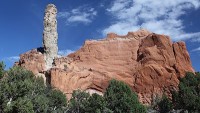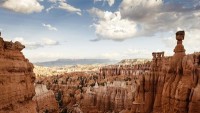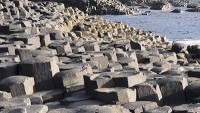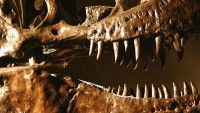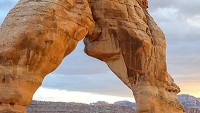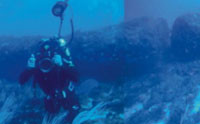Recent claims of a transitional species named Homo naledi have the anthropologic world in an uproar. The new fossil “species” is said to be a human-like ancestor that neatly fills the gap between the Australopithecus and our own genus Homo. This seemingly fits the human evolution story promulgated since the 19th century, but what are these bones really? More… …read more Read more here: icr.org
How do we explain ‘apeman’ fossils from a biblical perspective? …read more Read more here: creation.com
By Frost Smith Scientists were hoping for insight into why so many fossilized dinosaurs are buried in rock appearing to be in what’s been called the “throes of death” posture. …read more Read more here: AIG Daily
The Lake Missoula flood can’t be tamed by spreading it over long periods of time. …read more Read more here: creation.com
‘Mud cracks’, as they are commonly called, form when muddy sediment is exposed to the air and dries out. This causes the mud to dehydrate, shrink and crack. Some Bible critics claim that mud cracks disprove the global flood, because they are supposedly found throughout the geological record, and therefore imply a series of prolonged periods of drying out, instead of one great watery cataclysm that laid down most sedimentary layers. However, this argument is far from ‘rock solid’, because true mud cracks are easy to confuse with cracks formed by other mechanisms that don’t involve a period of drying [More]
By Bill Hoesch Secluded in the canyon country of southern Utah is a beautiful but often overlooked state park called Kodachrome Basin. …read more Read more here: AIG Daily
Questionable assumptions about how volcanic andesite lava is produced suggests caution before accepting uniformitarian interpretations. …read more Read more here: creation.com
Fossil leaves show that leaf miners have existed along with leaves and questions the long ages attributed to these fossils. …read more Read more here: creation.com
Homo naledi is another case of selective interpretation of the evidence to ‘prove’ evolution of man from apelike ancestors. …read more Read more here: creation.com
Explained by biblical history. …read more Read more here: creation.com
By Ken Ham Do you realize that Homo means different things to different scientists? When an evolutionist classifies a fossil as Homo, he does not mean the same thing a Bible-believing scientist does. There has already been a lot of buzz on evolutionists’ websites and blogs mocking our assessment that the published evidence does not support a Homo designation for Homo naledi. Ignoring how much evolutionary scientists disagree among themselves, some make much of disagreement among creationists about Homo naledi‘s identity. One in particular, in “Bones of Contention: How Will Creationists Respond To A Huge New Hominid Fossil Find?,”predicted responses [More]
Spring rains flooded the Dallas area this year, including Lake Grapevine which is about 10 miles west of the Institute for Creation Research (ICR) campus. Record water levels submerged entire lakeside parks and adjacent roads. As the water slowly receded, it revealed a reshaped shoreline—and dinosaur tracks. What kinds of creatures made these marks? More… …read more Read more here: icr.org
By Ken Ham The media is buzzing with news that another supposed human ancestor has been found in an African cave. It was discovered by evolutionist Lee Berger, whose controversial claims about Australopithecus sediba have been in the news off and on since 2011. (You can read them in “Sediba with a Little Sleight of Hand,” “Sediba Fossils Fail to Connect the Evolutionary Dots,” “Karabo: The Smiling Missing Link,” and “Can Karabo Catch Up with Lucy’s Legacy?”) Dr. Elizabeth Mitchell, who frequently writes articles for Answers in Genesis, is working on a full-length article on this discovery, so keep checking [More]
Richard Dawkins says a rabbit fossil in the Precambrian would be evidence against evolution, but would that really be the case? …read more Read more here: creation.com
Skeptics ask where are all the human fossils if there were really a global Flood? Are there answers? …read more Read more here: creation.com
By Dr. Andrew A. Snelling The visitor overlooks at Bryce Canyon, Utah, provide a breathtaking spectacle of row upon row of towering columns. …read more Read more here: AIG Daily
But Flood geology explains them. …read more Read more here: creation.com
By Dr. Andrew A. Snelling The Giant’s Causeway is Northern Ireland’s most iconic landmark. …read more Read more here: AIG Daily
By Dr. Elizabeth Mitchell Paleontologists have long wondered why dinosaurs are sparse in the Late Triassic rock layers of the presumed tropics of that supposed time. …read more Read more here: AIG Daily
By Dr. Andrew A. Snelling Located just outside Moab, Utah, is a wonderland of more than 2,000 natural arches. …read more Read more here: AIG Daily
By Dr. Andrew A. Snelling The Devils Marbles are an iconic landmark in Australia’s Outback. …read more Read more here: AIG Daily
An extraordinary fossil leaves a record of death which scientists are struggling to explain. We hope you enjoy this sneak peek from the soon-to-be-released Creation magazine. …read more Read more here: creation.com
Of all the scientific disciplines, underwater archaeology may be one of the most fascinating. These researchers examine artifacts our ancestors left behind before global sea level rose and covered them. A newly discovered monolith—a gigantic rock placed in what is today the Mediterranean Sea—confronts a few evolution-based errors about human origins. More… …read more Read more here: icr.org
By Dr. Elizabeth Mitchell Many evolutionists believe the discovery of a four-legged fossilized snake is evidence of a burrowing lizard in the snake’s evolutionary past, but is it? …read more Read more here: AIG Daily
By Dr. Terry Mortenson Noah’s Flood is the key to explaining most of the geological record and as such it washes away millions of years. …read more Read more here: AIG Daily
Proponents of an oxygen-less Earth atmosphere are faced with mounting evidence against the idea. …read more Read more here: creation.com
The Jurassic World movie, though thrilling to watch, comes packed with fictional ideas like de-extinction, designer creatures, and iron somehow preserving dinosaur DNA indefinitely. But how would the world respond if live dinosaurs were verified to scientists’ satisfaction? More… …read more Read more here: icr.org

























